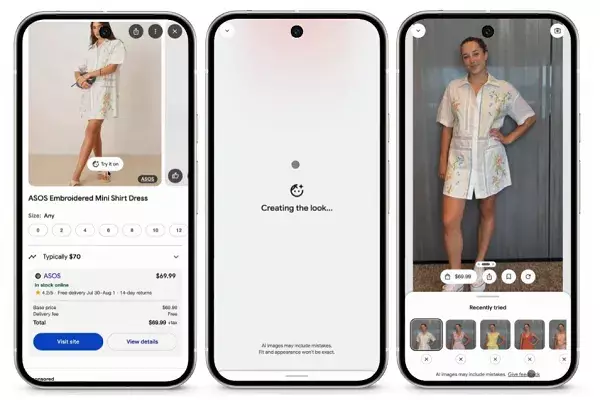Google’s latest innovations in shopping technology mark a significant leap toward a more realistic and immersive online retail environment. The introduction of advanced AI-driven virtual try-on features signifies a transformative shift in how consumers interact with apparel and accessories before making purchases. Previously confined to niche testing phases, this feature now offers everyday users the opportunity to visualize clothing on their own likeness, bridging the gap between digital convenience and physical certainty.
The capability to upload a selfie and see how specific items might look on one’s actual body shape can drastically reduce the uncertainty that often accompanies online clothing shopping. This isn’t merely about trying on clothes virtually; it’s about creating a personalized fitting room experience within the digital universe. Although the technology’s precision remains to be fully tested as it rolls out broadly, the potential for decreased return rates and increased customer satisfaction is undeniable. If this feature truly mirrors reality, it could revolutionize consumer trust and influence shopping behaviors profoundly.
However, critical scrutiny reveals that the success of such technology hinges heavily on its ability to accurately replicate how a garment appears on real bodies, accounting for different sizes, shapes, and movement. The initial promise might overstate efficiency, as AI’s current limitations in dealing with complex fabric drapes, lighting, and body dynamics could lead to mismatched expectations. Still, the leap forward cannot be dismissed: the ability to preview options on oneself may make online shopping a more engaging—and less frustrating—experience.
Empowering Consumers with Smarter Price Tracking
Another noteworthy feature is Google’s upgraded price alert system. In a retail environment overwhelmed by fluctuating prices and constant sales, staying informed has often meant juggling multiple tabs or relying on third-party tools. Google’s integrated price tracking simplifies this by allowing users to set customized alerts that incorporate preferences for size, color, and target price points directly within Google Shopping.
This development signifies a shift from reactive to proactive shopping. Consumers no longer need to hunt for discounts; instead, they can sit back as their personalized price tracker alerts them when deals align with their specifications. This system taps into Google’s extensive Shopping Graph, aggregating millions of products across various online retailers, ensuring comprehensive and up-to-date information. Such automation promises savings not only in cash but also in time, making the process of deal-hunting less burdensome.
Nonetheless, skepticism arises when considering the accuracy and timeliness of these alerts. The complexity of online pricing, potential delays in data synchronization, and the variability of sales across different platforms could hamper the efficacy of these tools. Yet, the core idea—empowering consumers to lock in deals seamlessly—remains a commendable stride toward a more transparent and consumer-centric marketplace.
Enhancing Discovery with AI-Driven Search and Recommendations
The final piece of Google’s recent updates emphasizes conversational, text-based product discovery. This feature leverages AI’s language understanding capabilities to interpret natural queries, providing tailored recommendations that align closely with user intent. The importance of this development cannot be overstated, as it shifts the shopping experience from rigid keyword searches to a more fluid, intuitive dialogue.
Imagine asking Google, “Show me stylish sneakers under $100 for running,” and receiving curated options that match this specific criteria. This functionality caters to the modern shopper’s desire for convenience and precision, reducing the cognitive load of sifting through endless listings. It also opens doors for more discovery, especially for consumers unsure of exactly what they want but know their style preferences and budget.
However, this innovation warrants a cautious appraisal regarding how well AI can truly grasp nuanced descriptions or interpret the subtleties of fashion trends. Misinterpretations could lead users astray, but even so, the potential for enriched, conversational interaction enhances both the pleasure and efficiency of online shopping.
While these features are still in their early stages, their successful integration could propel Google Shopping into a new era of sophistication and user empowerment. By combining personalized virtual fittings, smarter price alerts, and conversational search capabilities, Google is positioning itself as a transformative force in digital retail. If executed well, these innovations promise to make online shopping more intuitive, enjoyable, and aligned with individual preferences—an essential evolution in an increasingly digital retail landscape. Yet, critical oversight remains needed to ensure technological promises translate into genuinely reliable, seamless experiences for everyday consumers.


Leave a Reply